Everyone today understands mobile marketing's potential to produce business success. Mobile drives 20% of all e-commerce sales, and sales via mobile are projected to increase from $139 billion in 2012 to more than $400 billion in 2015.
One vital step toward capturing this potential is personalizing the mobile experience for customers. Mobile is personal, with every device feature, sound, and function customizable. Any marketer will acknowledge the demise of "spray and pray," replaced by data-focused segmentation and targeting. However, though 43% of companies deliver a personalized experience on desktop computers, only 13% do on mobile.
Fortunately, there are a few easy-to-implement tactics to personalize mobile for customers. Understanding each will help businesses monetize mobile more effectively.
1. Drive opt-ins
Perhaps this is obvious, but getting an opt-in opens up infinite possibilities for personalization. Be bold when encouraging customers to sign in on the mobile Web, submit their phone number to receive mobile alerts, or authorize push notifications when downloading apps. Consider Stuart Weitzman's homepage:
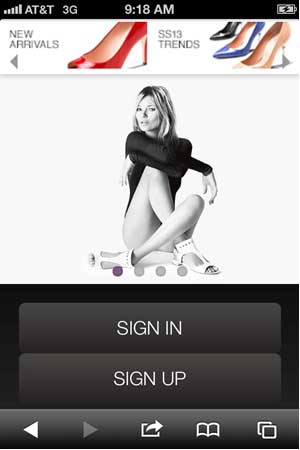
Whereas the page's top offers New Arrivals and Trends, a quick scroll reveals a gateway asking visitors to put on a nametag before entering. Moreover, on the desktop Web, Stuart Weitzman uses website-takeover popups for returning visitors, urging them to submit their email and/or mobile number to receive an optimal brand experience.
These practices demonstrate how companies can encourage consumer opt-ins without simultaneously alienating new visitors still in exploration mode. Overall, do not passively expect subscriptions to roll in. Think of mobile as if it were a real-life relationship. Be casual up front, but eventually you need to "have the talk" and actively drive signups.
For opted-in customers, provide custom features such as configurable navigation and targeted product recommendations. If consumers see demonstrable value in subscription programs, they not only will continue using mobile products but also will share the benefits with others.
2. Communicate across channels
Effective mobile marketers take a cross-channel approach that integrates the various mobile channels, such as SMS, app, Web, social, and Passbook. Here's one example from Electronic Arts:
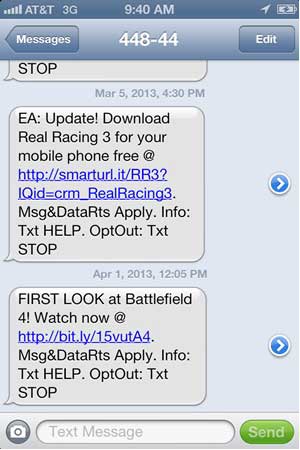
With the first message, subscribers to EA's SMS list can access a mobile Web page and download a Real Racing 3 app. The second opens a landing page where gamers can watch a mobile video promoting the game Battlefield 4.
Value comes behind the scenes, as EA can learn tons of useful information from these mobile interactions. For example, customers reveal their operating system when they download an app or open their Web browser. Those who view the mobile video mark themselves as high-value targets for the upcoming product release. Smart marketers collate such data points into one centralized customer profile—an ideal asset to maximize personalization for mobile.
Companies just getting started with cross-channel mobile marketing should focus on small wins. True cross-channel takes time and iteration, so commit to integrating what makes sense over the short, medium, and long terms instead of trying to do everything simultaneously.
3. Location-enable
Pretty simple really. Mobile devices go everywhere. Take advantage of how that information can create personalized experiences. One example:
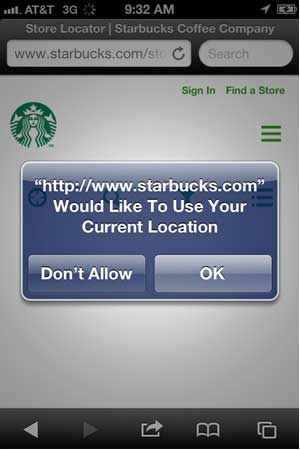
Starbucks uses a mobile Web store locator that asks customers to reveal their location, which then populates a map with nearby stores. Due to the nature of the information requested, consumers likely will find this data popup innocuous.
On SMS, marketers can request that customers share their ZIP code, whereas app and Passbook marketers can use location triggers for push messages. Remember, as long as customers see value in the call to action, requesting location information won't come off as pushy.
For those stuck on how to use location, start with four straightforward applications: time, weather, calendar, and geography. Tactics like "flash sale before 5PM," "Beat the chilly weather with this offer," "Special deal for summer," or "good morning" messages segmented by time zone will establish a stronger consumer/brand connection.
4. Provide choice
Choosing between options lets customers personalize through customization. ESPN's ScoreCenter app is a good example:
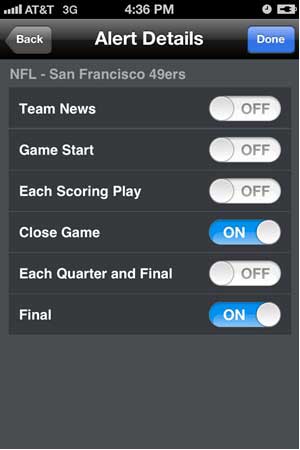
Here, customers can select the types of alerts they want to receive. Even though the alerts go to a general audience, the customers' input lets them create their own experience.
Even without an opt-in, brands still have the ability to implement choice-focused tactics using A/B Testing. Applicable to anything mobile—whether landing pages for inbound traffic, mobile message blasts, or individual app pages—the process is straightforward: Track success metrics for two alternatives, choose the best, compare that with a third alternative, then a fourth, and so on. Sure, A/B testing does not personalize content at the individual level, but generally it makes mobile media more engaging for customers.
5. View mobile through a data lens
When most marketers approach mobile, they gravitate toward viewing the technology as a communication channel. Savvy marketers understand that mobile produces much more value as a data channel. Consider this SMS campaign from Uber:
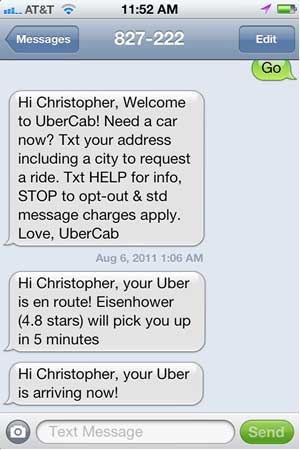
Yes, all these messages are communication between consumer and brand. However, between the lines the exchange gives Uber a chance to understand crucial information. Whether it's customer response time, average number of driver stars in a given location, or average time between the 5 Minutes and Arrive messages, each mobile interaction presents an opportunity to add value with data.
One specific example of Uber's data strategy is the use of customer first name. This tactic, dynamic field insertion, personalizes mobile interaction to increase engagement. Other data tactics include analysis of all on-site behavior to provide better content or "badging," where brands reward customer activity with prizes or other incentives.
* * *
Above all, remember that trying to implement all the above personalization tactics simultaneously will be overwhelming. Personalization is a crawl-walk-run endeavor. Bite off each tactic in chewable chunks, as each step forward will increase overall momentum.



